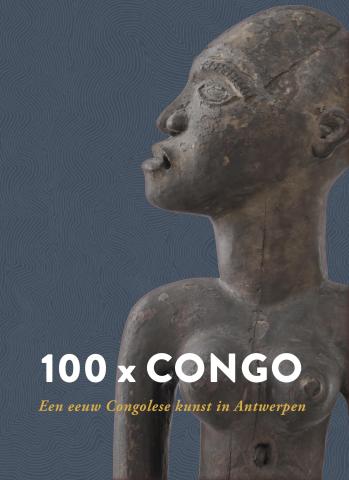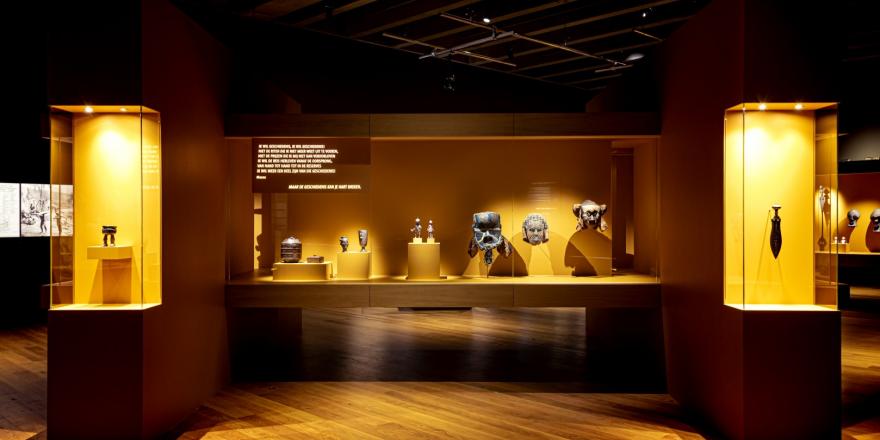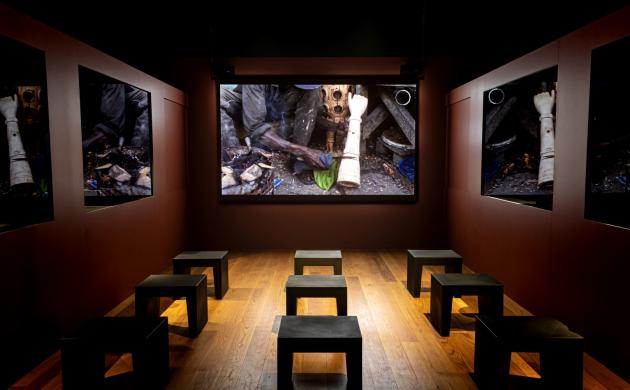Faute ya commerçant - Patrick Mudekereza
On the value of Congolese cultural objects in the MAS
I want history, I want history ! But history can break your heart (Patrick Mudekereza) |
Patrick Mudekereza, an artist-writer from Lubumbashi, has engaged in conversations on the Congolese collection with artists, (art) historians, anthropologists, policy makers and activists. His poems, spread throughout the exhibition, describe the various values of the objects: aesthetic, commercial, symbolic, scientific, spiritual. He also examines creation, trade, donations, loans and exhibitions.
The crime of plundering and acquisition without consent is often obscured by science, the art trade and a new sacralisation in museums. The artistic intervention in hand restores the art objects and utensils to their complexity. Mudekereza does this through conversations on our attachment to these objects. Perhaps we can thus prioritise the quest for their possible future. And avoid the pitfalls of researching their provenance.
The title, The vendor is to blame, is inspired by the song of the famous Congolese rumba singer Lutumba Simaro. It relates how a vendor of clothes is blamed for the injustice done to a cheated wife, as he has sold the same clothes to both her and her husband’s mistress.
Under the white mask - Matthias De Groof and Maravilha Munto
The film that Haesaerts could have made
The film Under the white mask was made for this exhibition by Matthias De Groof (b. 1981). It is a new montage of the art documentary Underthe black mask by the Belgian film director Paul Haesaerts (1901-1974). Haesaerts’ film from 1958 is about Congolese art objects and utensils.
Twenty of the highlights shown in this exhibition appear in his version. This educational art documentary might have been innovative, yet the content was stereotypical.
In the reworking by De Groof the sculptures are not talked about, but they themselves look at, and talk to us. They do so using the words of the poet, thinker and politician Aimé Césaire (1913-2008). His French text from 1950 was translated into Lingala, and holds up a troubling and still extremely topical mirror to Europe. The text as well as the music already existed by the time Haesaerts directed his film. According to De Groof, Under the white mask is the film that Haesaerts could have made.
- Realization: Matthias De Groof
- Voice: Maravilha Munto
- Text: (based on) Aimé Césaire’s ‘Discours sur le colonialisme’
Velours Kuba – Bren Heymans and embroiderers from Kasai
Old and new textiles in dialogue, 2018-2020
Kuba peoples from Kasai are world-famous for their embroidered fabrics in long-pile velvet and woven raffia textile. These are produced using ancient techniques. In the formerly strict division of labour, the weavers were men. Women took on the appliqué and embroidering.
In the mission posts the so-called velours Kuba underwent changes with time. From the 1930s onwards the complex imagery became tighter and more sterile.
This development is shown by Futur.Velours.com, a collaborative project created by the Antwerp artist Bren Heymans. He enters into dialogue with a number of Congolese female embroiderers from Ilebo (Kasai).
The website Futur-Velours.com gives a platform and a name to the women artists who continue the rich tradition of raffia embroideries in Kasai. The Shoowa’s (velours de Kasai) are artistic experiments that explore the medium and its charged history. The social impact that the project strives for is just as important as the new works that emerge.
In many hands
A project of the Belgian-Congolese film collective Faire-Part
In the multimedia project In many hands twenty-five people shine their light on the Congolese collection of the city of Antwerp. They speak about an object of choice from the one hundred highlights in the exhibition.
The narrators are inhabitants of the Congolese capital Kinshasa, citizens of Antwerp and people with a connection to the city by the Scheldt. The MAS engages in a dialogue with them about the various meanings of the Congolese collection, and the importance of a plurality of voices. They consider the highlights from different angles.
The objects raise numerous questions. What do they mean? What feelings do they evoke? Where do they belong?
The publication
In this book, Congolese and Belgian researchers look back together for the first time on the historical ties between Antwerp and Congo. The result is a special series of contributions about a shared and charged history.
The link between Antwerp and Africa was established in the sixteenth century, when the first trade relations were established, and continues through the colonization of the Congo until today. Buildings, monuments and street names in the Scheldt city still remind us of that past. At the same time, Belgian missionary and colonization have unmistakably influenced Congolese cultures.
In 1920, still in the colonial era, Congolese art and utilitarian artefacts came into the possession of the city of Antwerp for the first time. These objects are now part of the MAS collection. A selection of one hundred eye-catchers is central to this publication. Congolese researchers took a closer look and described their own heritage.

The catalog was published on the occasion of sixty years of Congolese independence and the centenary of the Congolese collection managed by the MAS | Museum aan de Stroom, Antwerp.
- 100 x Congo. Een eeuw Congolese kunst in Antwerpen (onder redactie van Els De Palmenaer), MAS BAI books, 2020 - ISBN 9789 0858 68101. D/2020/5757/10
- 100 x Congo. Un siècle d’art congolais à Anvers (sous la direction d’Els De Palmenaer), MAS BAI books, 2020 - ISBN 9789 0858 68118. D/ 2020/5751/11



